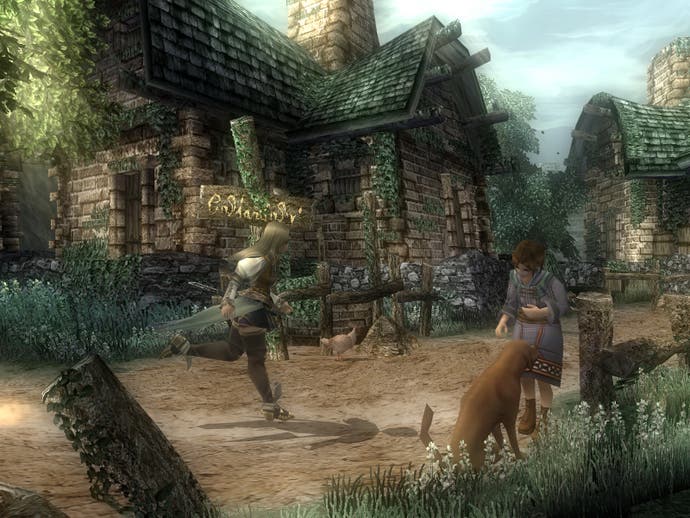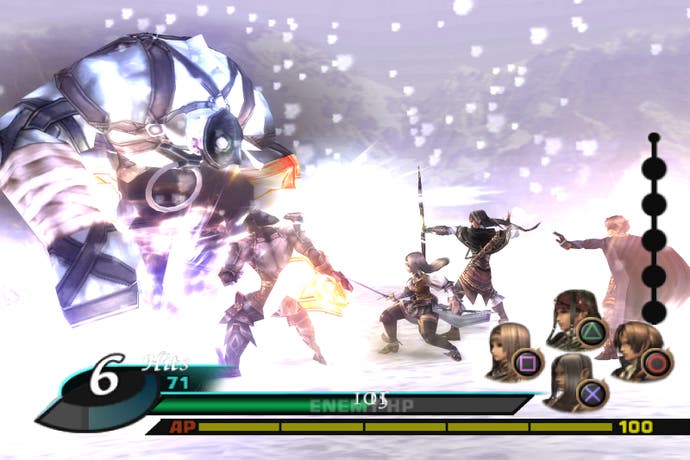Valkyrie Profile 2: Silmeria
Heaven.
The second thing you'll notice about Valkyrie Profile 2 is that you can only move your character left and right. In a bold move, the developers have inverted the traditional dimensions of an RPG. Towns and dungeons are explored like a classical 2D side-scrolling platformer, across flat, interconnected planes. Conversely, battles fling open the windows and throw the player out into fully 3D arenas - a plain swap for the tradition.
But, as I say, this remarkable decision will almost certainly be the second thing to grab your attention. It's love, at first sight.
The glorious if a little artistically passé FMV introduction hearkens back to Square's PSone era of stentorian visual introductions, and reaffirms the company's considerable talent for the lavish CG. But it's when the in-game visuals take centre stage, and through dilating pupils the player's pulled into a 16th Century French-style Centreville, that the jaw hangs loose and the heart-rate quickens.
Each camera angle and pan is perfectly pitched, and the scenery has an immemorial age and ambience that's missing from most game worlds outside of ICO's castle walls. Characters are dressed in lavish, Vagrant Story-esque costumes, dripping with understated, believable jewellery and the dust and grime of imagined history. Your window on their world is gently filtered through a washed out, melancholy lens that infuses colours with irresistible sadness. In this dulled light every century-old chip in the cobblestone, every tuft of weed in the cement and each creaking floorboard in the inn is perfectly and dramatically accentuated.
For players that missed the first Valkyrie Profile on PSone (hopefully coming to European PSPs in the new year) this series unusually clothes itself in Norse mythology and centres around the Valkyrie, one of the servants of Odin king of the gods. It is the Valkyrie's job to first choose and then appear before the bravest and the best humans at their moment of death in order to invite them to serve the Gods in heavenly battle as 'Einherjar'.
In this prequel to the first game the titular Silmeria, the youngest of three ethereal Valkyrie sisters, has been banished from heaven by Odin, king of the gods, for some unspecified offence. She's been sent to Midgard - to exist as a soul entity living in the body of Alicia, Princess of the Kingdom of Dipan. But Alicia's mind and soul also occupies her body, and so the game opens with a confusing scene with the royal teenager having a heated discussion on a street corner, drawing, in equal measure, the concerned and terrified glances of passers-by - since she's having said discussion exclusively with herself.

Alicia has little choice but to aid the resident Silmeria in her quest to get back at Odin for exiling her and the pair set off inside the one body, enlisting the help of both mortals and Einherjar to their cause as they go.
It's this kind of irreverence for RPG convention that endeared the first game to fans and pleasingly the innovation extends to almost all areas. It's a bold move casting the player this way, but one that works in the game's favour - otherwise fairly slow-burning, with the characters that join Alicia's troupe Lost-esque in their straightforward archetypes, having such an intriguing start point helps balance a plot that might otherwise have settled into cliché and helps spur the player on through the narrative.
Valkyrie Profile 2's wider world is divided into Fire Emblem-style location points. On the world map you simply select where you want to go and you're transported there. The aforementioned exploratory areas are rendered in full 3D but the player exists on a single 2D plane, so it's quite a surprise - when you first enter a lavishly designed and functioning town - only to be able to walk left and right and occasionally push up to enter a house or side-street. Likewise, the dungeons play in the same way, albeit also requiring the player to make difficult jumps on the Y-axis and solve (mostly straightforward) puzzles in order to access high platforms and rare treasure chests.
"Photons", the ice crystals from the first game, make a return, allowing you to temporarily freeze the visible enemies (no random battles here), and then use their rigid bodies as platforms. Your other platforming tool is the ability to swap places with an object you've frozen by shooting a second photon into it. As photons can be bounced off walls and fired at 45-degree angles, these two simple devices provide the developer with countless opportunities to stretch the player's imagination in working out how to fully uncover the sprawling, Castlevania-like dungeons. An excellent map system allows you to keep track of your progress through each area and chart how much of its contents are left to discover and this well-executed and inventive aspect of the gameplay provides a solid bedrock for the rest of the thing to build upon.
In particular, all of this tight, responsive platforming (a clear demonstration to games like Wild Arms 4 of how to successfully implement such a design choice into an RPG) is but an appetiser to the glorious battle system. Touching an enemy when not frozen switches the game into the aforementioned 3D arena. Brilliantly engaging and fast-paced, the fight system allows for player emphasis on either strategy or action, while requiring an almost meticulous demonstration of both for success in the tough and intricate boss fights.

Control of each of the four members of your team is mapped to the PS2 controller's face buttons and, if in range of an enemy, you can quickly and easily trigger an attack with no need for menu navigation. By hitting the buttons in different sequences (so triggering each character's move at a slightly different time) you string together different combos. Mashing the buttons works, but planning carefully reaps far higher rewards as by amassing 100 hits in a single combo you can trigger devastating special moves - a necessity for many later foes.
The emphasis is also on clearing fights as quickly as possible as a timer counts down during the battle. Defeat the enemy leader (as his death brings the fight to a close even if other minions are left standing) within the time limit and you receive a bonus item. Meanwhile, enemy bodies are divided into parts and destroying all of their body elements and all of the enemies will garner the greatest experience point reward. So there's a clever trade off between choosing to move quickly to receive a special item and being methodical to receiving maximum experience.
Your team can also be split up during fights and three different types of dash moves (during which time you're invulnerable) add a frenetic pacing to each skirmish. An astute player quickly overcomes the complexity of the system but understanding the statistical development of your team and its ongoing management is more difficult. Each character has nine slots for equipment, which boost their effectiveness in offence and defence play. However, much of the equipment is marked with a class symbol. By linking together items with compatible symbols you can unlock high statistical bonuses for your team members. Skills are also unlocked for characters, which can be tied to specific equipment and the result of these layers of depth is a system that takes some time to get your head around. In this sense the game shares a lot in common with the aforementioned Vagrant Story and fans of that near-infinitely customisable game will find a similar chance for expression here.
Completing the gameplay chassis is the abundance of recruitable characters scattered throughout the world. Many of the Einherjar are trapped in artefacts hidden in towns and dungeons and there's a certain gotta-catch-'em-all compulsion to finding them all. This is helped - where Suikoden's similar system fails - by the fact that, once sufficiently levelled up, you can mercifully release your Einherjar team members and in return gain high level and rare equipment that other characters can use. Released characters that were once in your team reappear throughout the world and can be found for extra bonus items.
For the player that chooses to rescue and release every Einherjar the game becomes something of a mountainous level-grind to wear even the most hardened JRPG fan down. The optional dungeons that contain rare items will, at this point, likely drive the completist close to breaking point. But, to most players, levelling Einherjar and collecting the rare treasures are optional extras, and as such the game skilfully manages to provide for the (relatively) casual player as well as the steel-willed enthusiast.
Silmeria is a wonderfully fresh experience, even though it essentially just builds on many ideas first laid out in its predecessor some years ago. The potent mixture of action with the high-level statistical balancing will quickly seduce the right-minded player. The developers manage to draw elements from many other genres and series without the game ever feeling like a patchwork or mere pastiche. Indeed, as JRPGs go this is comfortably the most inventive yet seen on PS2 - both in its gameplay theory and the physical outworking of its exquisite environments. Anyone with even a passing interest in the evolution of Japanese role-play will find much to think upon after the glow of in-game satisfaction has dissipated when the pad is finally put down.

